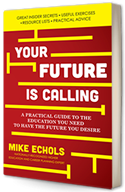There are good paying jobs that don’t require a bachelor’s degree but they do require skills that are changing as our world changes. Learning is still key to a better future. But how do you decide what to learn? The answer is that you should begin with “who you are” then decide what to study that can lead to a better future for yourself and your loved ones.  Source: O*NET The O*NET program is the nation’s primary source of occupational information. Every occupation requires a different mix of knowledge, skills, and abilities, and is performed using a variety of activities and tasks. The data base defines the set of occupations across the world of work. Based on the Standard Occupational Classification the O*NET-SOC taxonomy currently includes 974 occupations
Source: O*NET The O*NET program is the nation’s primary source of occupational information. Every occupation requires a different mix of knowledge, skills, and abilities, and is performed using a variety of activities and tasks. The data base defines the set of occupations across the world of work. Based on the Standard Occupational Classification the O*NET-SOC taxonomy currently includes 974 occupations
With so many occupations to select from, it is no wonder that readers are challenged to find just the right combination of factors needed to fit exactly “who they are”. In this post we explore the important characteristics of a few of the 974 choices to show how a new career can be chosen. I recommend that you look at several important characteristics for any career you may be considering. These are:
* The size of the profession. This gives you an indication of how many jobs in this profession there are in the US economy. Here size matters. Larger professions provide more opportunities.
* Growth in the profession is another important parameter for you to consider. As our world changes opportunities in different careers are changing as well. Some careers attractive just a few years ago have already been impacted by changes. A good example is desktop publishing. Only a few years ago this was a growing job opportunity. Today this profession is much less attractive with a very limited growth prospect.
* Earnings are another important piece of information in your career choice. Incurring student debt to earn credentials in a poorly paying occupation is a path to a dismal future.
* How well the occupation fits you is another important factor. This is the part about “who you are”. Here again you need good data about personality and the characteristics of those already in the profession.
Here is data on a few of the 974 careers. All of these require less than a bachelor degree and are reasonably accessible through education at a community college at a reasonable investment level.
This is a profession that, with the right personal history, is relatively easy to enter. 42% of current officers entered the profession directly from high school but an associate’s degree provides better prospects. It is a large profession with 664,000 current positions growing by 249,000 (2010-2020). The median pay is $55,270 per year. This profession requires personal attributes that include integrity, self control, stress tolerance and attention to detail.
This is a reasonably large job classification with 182,000 current positions with over two thirds occupied by professionals with an associate’s degree making it a relatively easy profession to enter through a very affordable path at a local community college. Growth is projected to be over 29% (2010-2020) and compensation in 2012 was highly attractive with an annual median income of $70,210. In addition to technical training required, personality attributes that align with the requirements of the job include a good-natured and cooperative attitude.
This is a large employment category with employment of 256,000 with good growth projected over the next decade. The median salary in 2012 was $46,990 annually. Apprenticeships by state are available. In addition, certificates are available from The Association of Legal Assistants/Paralegals. Personal attributes including attention to detail, dependability, and integrity.
Registered Nurse
This is a huge profession with 2010 employment at 2,737,000 with projected openings by 2020 of 1,207,400 professionals. This size and growth are being driven by new medical technology and the aging of the baby boomers. Compensation is attractive at a 2012 median level of $65,470 annually. Personality attributes important in this profession include concern for others, dependability, stress tolerance, self control and attention to detail.
Summary: All of these careers can be entered with learning that is less than the traditional bachelor’s degree. This makes learning a key but manageable entry to these attractive professional careers.
